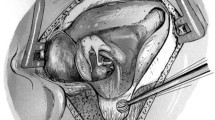Summary
Treatment of retraction pockets (RP) and cholesteatomas depends on their nature and evolvement and the size of mastoid pneumatization. RP are secondary to vacillating middle ear negative pressure. Treatment when necessary consists of placing a ventilating tube, excision of the RP or both. In most children and adults, cholesteatoma is derived from RP (or “atelectasis”) of the tympanic membrane, where it can be termed “retraction pocket” cholesteatoma or “secondary” cholesteatoma. This type of cholesteatoma is associated with a non-pneumatized mastoid coupled by negative pressure. Approximately one-third of children's cholesteatomas present clinically behind an intact drum despite a pneumatized mastoid. Pathogenetically this type may be “congenital” or “metaplastic” and should be best termed “primary” cholesteatoma. Central perforations associated with cholesteatoma are probably derived from continuous tympanic membrane destruction by infection in cases of RP cholesteatomas or due to a primary cholesteatoma bursting out from the tympanic cavity. Canal-up surgery of cholesteatoma fails in 60% of cases at Tel Aviv University because of the inherent tendency of the tympanic membrane to retract once again. Residual disease was found in our cases to be a lesser cause for failure. Treatment depends on the type of cholesteatoma, emphasizing small “radicals” in sclerotic mastoids. When a pneumatized mastoid is encountered, a posterior tympanotomy should be considered.
Similar content being viewed by others
References
Avraham S, Sadé J (1986) Surgery of atelectatic ears and retraction pockets in acute and secretory otitis media. In: Sadé J (ed) Acute and secretory otitis media. Kugler, Amsterdam, pp 551–554
Avraham S, Luntz M, Sade J (1991) The influence of ventilating tubes on the surgical treatment of atelectatic ears. Eur Arch 248:259–261
Buckingham RA, Ferrer JL (1966) Reversibility of chronic otitis media with polyethylene tube ear air-vent, kodachrome time lapse study. Laryngoscope 76:993–1014
Cody DTR, TaylorWF, Jansen C, Smyth GPL, Palva T, Karma P, Palva A, Baron SH, Write WK, Edo T, McCabe B, Abramson M, Austin DF, Sadé J, Bennuc R, Skuknecht H, Cosscock ME (1977) Evaluation of surgical procedures for cholesteatoma. In: Macabe B, Sadé J, Abramson M (eds) First International Conference on Cholesteatoma. Aesculapius, Birmingham, Ala., pp 336–418
Jansen C (1963) The combined approach tympanoplasty. J Laryngol 82:793–799
McGill IT, Merchant SM, Healy GB, Friedman EM (1991) Congential cholesteatoma of the middle ear in children: a clinical and histopathological report. Laryngoscope 101:606–613
Palva T (1992) Reconstruction of ear canal in surgery for chronic ear. Arch Otolaryngol 75:329–333
Sadé J (1963) Reconstruction of posterior canal wall in obliteration of radical mastoidectomies. Arch Otolaryngol 78:127–131
Sadé J (1982) Treatment of cholesteatoma and retraction pockets. J Laryngol Otol 82:585–704
Sadé J, (1993) Cholesteatoma and mastoid pneumatization. Ann Otol Laryngol (in press)
Sadé J, Berco E (1974) The inflammatory factor in bone destruction in chronic otitis media. J Otol 88:413–422
Sadé J, Berco E (1974) The atelectatic ear and secretory otits media. Ann Otol Rhinol Laryngol [Suppl] 25:85:66–73
Sadé J, Halevy A (1976) The etiology of bone destruction in chronic otis media. J Otol Laryngol 88:139–143
Sadé J, Pinkus G (1983) Metaplastic and congenital origin of cholesteatoma. Acta Otolaryngol (Stockh) 96:119–129
Sadé J, Shatz A (1988) Cholesteatoma in children. J Laryngol Otol 102:1003–1006
Sadé J, Avraham S, Berco E (1981) Atelectasis, retraction pockets and cholesteatoma. Acta Otolaryngol (Stockh) 92:501–512
Sadé J, Berco E, Brown M (1981) Results of mastoid operations in various chronic ear diseases. Am J Otol 3:11–21
Sadé J, Weinberg J, Berco E (1982) The marsupialized mastoid. J Laryngol Otol 82:585–704
Sadé J, Berco E, Fuchs L (1986) Results of preservation of posterior wall in cholesteatoma surgery as related to middle ear aeration. J Laryngol Otol 100:1351–1358
Sadé J, Lunz M (1993) Middle ear gases. Acta Otolaryngol (Stockh) (in press)
Tos M (1982) Can cholesteatoma be prevented in cholesteatoma and mastoid surgery. In: Sadé J (ed) Cholesteatoma and mastoid surgery. Kugler, Amsterdam, pp 591–597
Author information
Authors and Affiliations
Rights and permissions
About this article
Cite this article
Sadé, J. Treatment of cholesteatoma and retraction pockets. Eur Arch Otorhinolaryngol 250, 193–199 (1993). https://doi.org/10.1007/BF00171523
Received:
Accepted:
Issue Date:
DOI: https://doi.org/10.1007/BF00171523




